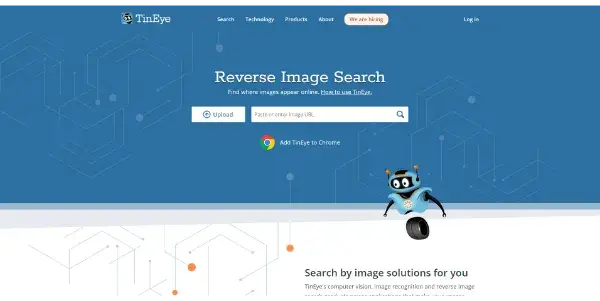TinEye

A search engine specializing in image recognition (reverse). Applications: content moderation, fraud detection, online image tracking, etc.
TinEye: A Deep Dive into Reverse Image Search and AI-Powered Applications
TinEye is a powerful, free reverse image search engine that leverages AI-powered image recognition technology. Unlike traditional search engines that rely on text, TinEye allows users to upload an image or provide a URL and find where that image, or visually similar images, appear online. This capability opens up a wide range of applications across various sectors, from content moderation to fraud detection.
What TinEye Does
TinEye's core functionality revolves around its ability to identify and locate images across the vast expanse of the internet. It works by creating a unique "fingerprint" of an image, essentially a mathematical representation of its visual content. This fingerprint allows TinEye to quickly and efficiently search its massive index of billions of images, identifying exact matches or near-duplicates, even if the image has been modified slightly (resized, color-adjusted, etc.).
Main Features and Benefits
- Reverse Image Search: The primary feature, allowing users to upload an image or provide a URL to find its origin and other occurrences online.
- High Accuracy: TinEye boasts a high level of accuracy in identifying even slightly altered images, thanks to its advanced image recognition algorithms.
- Comprehensive Index: TinEye's index comprises billions of images from across the web, increasing the likelihood of finding relevant results.
- API Access: For developers, TinEye offers an API for integrating its reverse image search capabilities into their own applications.
- Multiple Output Formats: Results are presented in a user-friendly manner, clearly showing the source URLs and visual similarity scores.
- Free to use: This makes the tool accessible to a broad range of users and organizations.
Use Cases and Applications
TinEye's capabilities translate into practical applications across several domains:
- Content Moderation: Identify and remove copyrighted or inappropriate images from websites and social media platforms.
- Fraud Detection: Detect instances of counterfeit products or fraudulent online listings by comparing images to known legitimate sources.
- Online Image Tracking: Monitor the spread and usage of specific images online, tracking their appearance across different websites and social media channels.
- Brand Protection: Identify and address unauthorized use of brand logos and imagery.
- Reverse Image Research: Find the original source of an image, useful for journalists, researchers, and educators.
- Duplicate Image Detection: Identify duplicate or near-duplicate images within a large dataset, valuable for archiving and database management.
Comparison to Similar Tools
While several other reverse image search engines exist (e.g., Google Images, Yandex Images), TinEye distinguishes itself in several key aspects:
- Accuracy and Coverage: TinEye generally excels in identifying even subtly modified images and boasts a comprehensive index.
- API Availability: Not all competitors offer a readily available and well-documented API for integration.
- Historical Image Tracking: TinEye's extensive archive allows tracking the image's history, which is not always possible with other tools.
Pricing Information
TinEye's core reverse image search functionality is completely free to use. While advanced features or large-scale API usage might have associated costs for enterprise clients, the basic service remains accessible to everyone.
In conclusion, TinEye provides a powerful and versatile solution for anyone needing to perform reverse image searches. Its accuracy, comprehensive index, and free accessibility make it a valuable tool across numerous industries and applications. The ability to identify and track images online holds significant implications for content management, fraud prevention, and brand protection in the digital age.